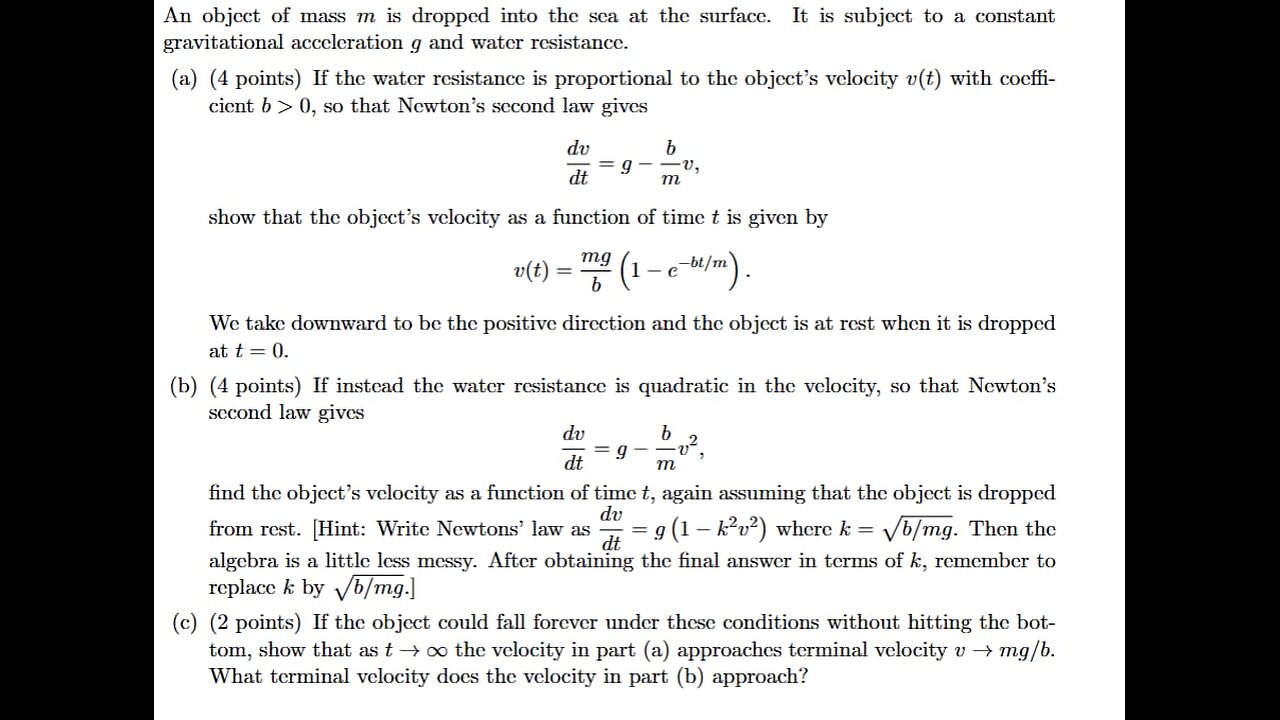Premium Only Content

Calculus Help: An object of mass m is dropped into the sea at the surface. It is subject to a
An object of mass m is dropped into the sea at the surface. It is subject to a constant gravitational acceleration g and water resistance. (a) (4 points) If the water resistance is proportional to the object's velocity v(t) with coefficient b ≫ 0, so that Newton's second law gives b dv/dt =g- b/m v show that the object's velocity as a function of time t is given by v(t) = mg/b (1-e^(-bt/m)). We take downward to be the positive direction and the object is at rest when it is dropped at t=0. (b) (4 points) If instead the water resistance is quadratic in the velocity, so that Newton's second law gives dv/dt =g- b/m v^2 dt m dv dt find the object's velocity as a function of time t, again assuming that the object is dropped from rest. [Hint: Write Newtons' law as = g(1 − k^2v^2) where k = √b/mg. Then the algebra is a little less messy. After obtaining the final answer in terms of k, remember to replace k by √b/mg.] (c) (2 points) If the object could fall forever under these conditions without hitting the bottom, show that as t→ ∞ the velocity in part (a) approaches terminal velocity v → mg/b. What terminal velocity does the velocity in part (b) approach?
#CalculusHelp
#Integrals
#differentialequations
#PartialFractions
-
 LIVE
LIVE
Lofi Girl
3 years agolofi hip hop radio 📚 - beats to relax/study to
138 watching -
 56:38
56:38
DeProgramShow
2 days agoDeprogram with Ted Rall and John Kiriakou: "Jake Tapper on the Global Hunt for an Al Qaeda Killer”
21.9K6 -
 16:30
16:30
GritsGG
2 days agoWarzone's New Zombie Royal Mode is AWESOME!
782 -
 1:43:07
1:43:07
The Michelle Moore Show
3 days ago'The 12 Open Doors' Guest, Steve Jarvis: The Michelle Moore Show (Oct 17, 2025)
30K13 -
 30:55
30:55
TruthStream with Joe and Scott
7 days agoTruthStream in Ireland, Rebels Across the Pond, Bono discussed, with Freedom Now Acoustic from a Pub
3.72K12 -
 3:12:34
3:12:34
Badlands Media
22 hours agoThe Narrative Ep. 43: Unity.
313K75 -
 2:43:11
2:43:11
TheSaltyCracker
7 hours agoWe Kill You Rally ReeEEStream 10-19-25
84.9K236 -
 7:54:17
7:54:17
Putther
13 hours ago $20.59 earned🔴LAZY SUNDAY STREAM!! (GTA + MORE)
68.3K12 -
 10:38
10:38
Colion Noir
6 hours agoHe Installed a Forced Reset Trigger at a Gun Range… and Got Arrested | What You Need to Know
54.4K21 -
 1:29:26
1:29:26
HELMETFIRE
6 hours ago🟢GAMING WITH FIRE EP13🟢
25.8K4